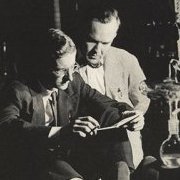-
Posts
4586 -
Joined
-
Last visited
-
Days Won
12
Content Type
Profiles
Forums
Events
Everything posted by hypervalent_iodine
-
I'm not entirely sure what laundry ink is, but I would imagine there would be a few. If you look up phenolic resins + printing ink, you should find a few. What is this for?
-

"Mixed" Hydro-carbon carbo-Hydrates ??
hypervalent_iodine replied to Widdekind's topic in Organic Chemistry
Are you asking whether a hydrocarbon chain can carry multiple hydroxyl groups but not be a carbohydrate? The answer to that is, absolutely. The modern definition of a carbohydrate simply refers to it being a sugar, or a polyhydroxy aldehyde/ketone. So that leaves a whole bunch of potential compounds that have multiple hydroxyl groups, but that are not considered a carbohydrate. -
I think that you should listen to this post:
-
A. I wouldn't call a methyl group a functional group. You maybe need to think in more general terms than that. I can't really help with the rest until I know which Ciguatoxin you're talking about. Can you post a picture?
-

Can Someone tell me what type of reaction this is:
hypervalent_iodine replied to Help-Me-Please-&Quick1's topic in Chemistry
You're right in thinking it's an oxidation/reduction type reaction, but since this is a homework question I am obliged not to simply give you the answer as to why. What do you understand about redox reactions and what do you think would make this a redox reaction? -
I have at least two styles of handwriting that I flick between regularly, none of which is the same as anyone in my immediate family. I doubt there's any truth to it.
-
No problems. Feel free to come back with any other questions
-
For your first question, I can't remember if Isaid A or B. It was definitely one of the esters though. Also, I think you need to have anther quick look at your spectra for this question. The alkyl peaks you have are a little too high for a methyl group. The splitting for both looks to be two triplets, which means that both are methylene protons (CH2 groups). As well, you have a pretty strong MS peak with an m/z of 65, which corresponds to a loss of CH2CH2OH. And no problems! NMR can be a bit tricky sometimes. The best way to learn it is to keep practicing with examples like this. Oh and you should look up information on how para, ortho and meta disubstitution on aromatic rings changes splitting patterns. It's very useful information to have under you belt in these questions.
-
It wouldn't be A. 270nm is typical of an aromatic group, so A is eliminated. Also, your 1H NMR shows aromatic peaks at ~ 7.3ppm. You don't necessarily see and -OH peaks in an NMR spectrum if you haven't done a D2O shake. So don't worry that you can't see it. Also, if that reasoning is good enough for B-D, then how come you chose A, which also has an OH group on it? I would look at a few things for this: firstly, are any of the shifts typical of methyl group and secondly, what would give rise to the splitting pattern observed on the peaks at 2.8ppm and 3.6ppm? From that you should be able to work it out. The other way you could look at it is by looking at how the aromatic protons are split. Different substitution patterns on an aromatic ring (para, meta, ortho) will give rise to different splitting in the aromatic region. It sometimes takes a trained eye to see it though.
-
Had a look at the pictures. You should have been able to figure out it wasn't an aldehyde given the structures you're provided with in the second question (none of them are aldehydes, but one of them has to be your molecule). Have you managed to work out the second question yet?
-
3.7ppm is most definitely not an aldehyde proton. You would expect such a proton to occur at around 9ppm, give or take. Also, I am skeptical of foreign links, so could you post the picture in the thread or have it as a pdf attachment?
-
But I gave you a chemical description? It should just be elemental carbon.
-
Chocolate in your sulphuric acid is a common problem? I tried doing a few searches for you, but couldn't find much about any trivial name for the stuff.
-
Clicking the link you gave takes me to microsoft outlook. Not to worry, I found and watched the video. They say the name of the putty, but I can't understand what they're saying. WHy do you need to know it's name?
-
Conc. sulfuric acid reacts with sucrose (and other sugars) in the chocolate and generates an exothermic dehydration reaction, giving water (in the form of steam) and elemental carbon. I'm pretty sure it's the carbon that tars the hole. There's a bunch of you tube videos, etc. that you can watch if you google sucrose plus sulfuric acid.
-
There are of course a number of naturally hermaphroditic animals, but very, very few will self-fertilise. Plants can self-pollinate, but so far as I am aware this is the only known vertebrate that can self-fertilize. I'm not sure about other types of animals though.
-

Science teaching: It's the method that counts
hypervalent_iodine replied to Cap'n Refsmmat's topic in Science News
The problem with this, especially in the earlier years of a science degree, is that a professor has a far more expansive and detailed knowledge of the subject than is feasible to teach. You say that your lectures are presently a 'data dump', so I have to ask you how on earth you think that will improve by a professor divulging all of his knowledge on a given subject in the context of an undergraduate level class? If anything, this will make it much more difficult for a student to learn, as they are trying to process too much complex information before they have a firm grasp on the basics. It is counterproductive at best, in my opinion. Perhaps this is true for the USA, but it certainly is not so in places where university education is free or (As in my case) student loans are easily attainable and affordable. The phrase 'this isn't highschool' is quite pertinent. In high school you are essentially spoon fed all that you need in order to pass or do well. University, as has been mentioned, is a place to facilitate learning, not to present everything to you on a shiny platter, wrapped in a bow. You have to take responsibility for yourself and your work and apply a little initiative to achieve anywhere near decent results - hardly an unfair expectation. In reference to the OP: I recently completed a post-graduate course where the lectures were prepared and presented entirely by students. The lectures were sat i on by a professor, who asked questions and pointed out any errors as they arose, so there was no risk of being taught anything incorrect, etc. I think at post-grad level it is productive in the sense that it teaches students how to research and present foreign material in a manner conducive towards learning, which is certainly a handy skill to have. In larger undergraduate classes, where students don't have a good grounding of the basic knowledge, there is a much larger room for error and the size of the class would make it logistically unfeasible. I don't agree that such a situation would be at all productive. -

Organic Chemistry Reference Sites
hypervalent_iodine replied to hypervalent_iodine's topic in Organic Chemistry
If you have access to SciFinder, the CAS database is available through that. You won't find a full database anywhere else I don't think. The CAS database is under the ownership of ACS and is copyrighted. Websites are allowed to list no more than 10000 entries without accruing a charge. -
This thread is from 2005. I doubt the help is needed anymore.
-
I am by no means skilled at math, but it sounds as though you want to know how to derive the quadratic equation. I found this site, which goes through it step by step: http://www.purplemath.com/modules/sqrquad2.htm
-
You should be considering heat as more of a type of energy, rather than simply temperature. The point of exo and endo thermic reactions is that the former releases energy in the form of heat and the latter requires energy to form. It may be useful for you to read this: http://en.wikipedia.org/wiki/Enthalpy I would write a more detailed reply, but I'm afraid my procrastination has to come to an end. I'm sure mississippi can help you with any further questions.
-
You need to look at it from a different angle. What you are describing is a process of heat transfer. The refrigerator isn't sucking anything out at all. The heat is being transferred from the glass, which is of a higher temperature, to the surroundings (the refrigerator), which is of a lower temperature. Simply put, the two systems are trying to reach thermal equilibrium. So to answer your question is no different to how I answered it previously. The heat comes from the glass. Did you want to know anything more than that?
-
I'm not sure I understand your question. Heat has a few definitions, but in science it's simply a form of energy which may spontaneously flow from one system to another. In your case, from the glass to the surroundings. Could you be more specific with what you're after here? I'm almost sure I haven't answered your question the way you intended it.
-
Well, they know how to party upon occasion. The occasions are usually limited to rugby union type events, however. Though it would seem I now have to extend that list to impending doom as well. Also, I'd be doing you a disservice if I didn't pre-warn you about the non-existence of summer in NZ. I'm slightly bias though.
-
I can confirm that Australia made it to Sunday rather anticlimactically. I rang my sister in NZ last night to see if she was enjoying her rapture. Turns out they really know how to bring on the end of the world over there - everyone was having rapture parties and getting roaringly intoxicated. I guess repenting is for the weak over there.

